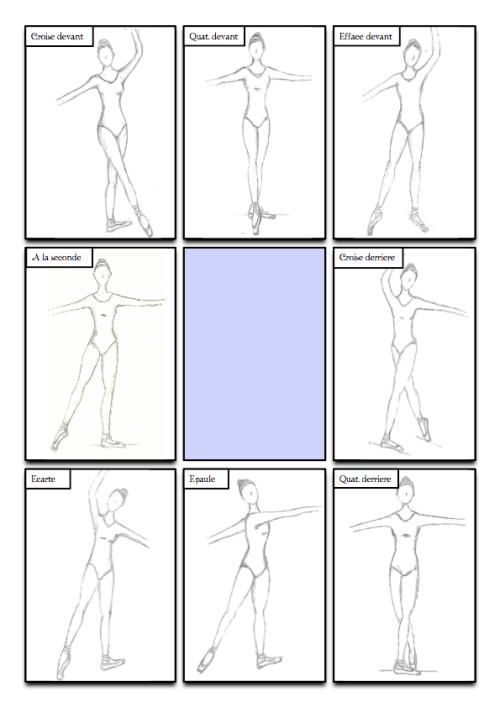We are back with another edition of Bag of Steps. This time we look at every turning trick designed to make us go “whoa” and typically reserved for the grand finale, such as in the coda from a Pas de Deux .
Turns include female and male pirouettes and their offshoots. For the ballerina they are the signature bravura step, the ability to turn in 32 fouettées being her ultimate technical benchmark. For the danseur they are powerful wizardry tools, especially those multiple turns generated from a single impulse.
Pirouette
Spin. A complete turn of the body on one foot. The supporting foot can be either on pointe or demi-pointe, with the working leg positioned sur le cou-de-pied, in arabesque, à la seconde, in attitude, etc. Legs give the impulse from a deep plié in preparatory position, arms control the turning speed and the head is the last part of the body to turn away from an imaginary “spotting” point and the first to hit the point again once the body completes the turn.
Pirouette en dedans: a pirouette which turns inwards. The body turns towards the supporting leg, so if the dancer turns on the right foot, the dancer turns to the right.
Pirouette en dehors: a pirouette which turns outwards. The body turns towards the raised leg, so if the dancer turns on the right foot, the dancer turns to the left.
A dancer from Pennsylvania Ballet demonstrates a sequence of pirouettes en dehors.
Grand Pirouette, Pirouette à la seconde (also, Tours à la seconde): Pirouette with one leg raised at 90 degrees. These are typically performed by men. Starting from fifth position with a grand battement into second position, legs lower into demi-plié to propel the turns. The arms start in second position and close in first, the right leg is raised into second with a swift movement for each turn en dehors.
Mikhail Baryshnikov does a Grand Pirouette in this video of ABT’s Don Quixote.
Fouetté
Whipped. In this step the raised foot undergoes a short “whipped” motion as it passes in front of, or behind, the supporting leg to the opposite direction. There are many types of fouettés. Here we will focus on those en tournant (ie. while turning).
Grand Fouetté en Tournant (Italian Fouettés): Starting in arabesque, the dancer goes from a deep plié into a series of relevés en pointe or demi-pointe while swinging the back leg to the front. The arms move from first to fifth position. In a half turn, the body moves away from the lifted leg and ends in arabesque (or attitude, with the back to the audience). In a full turn, the leg is held devant until the body shifts through arabesque to start the movement again with the leg swept from the back.
Yekaterina Kondaurova does a series of (full) Italian Fouettés in the Queen of the Dryads Variation of Mariinsky‘s Don Quixote. Move forward to the 1:21 mark.
Fouetté Rond de Jambe en Tournant (Russian Fouetté turns): Starting on fourth, the dancer does a pirouette en dehors and then a demi-plié (fondu) while the working leg is thrown à la seconde. While the supporting leg relevés to pointe the dancer turns bending the working leg’s knee and passing the foot from behind to the front of the supporting leg. At the start of the series the arms open in second position to follow the leg and are brought into first while turning.
Svetlana Zakharova throws a sequence of fouettés en tournant during the coda of Don Quixote’s Grand Pas de Deux.
Fouetté Rond de Jambe en Tournant (Cecchetti Fouetté turns): Instead of extending the working leg à la seconde, the dancer throws the leg towards croisé devant en l’air, sweeps it à la seconde and turns while bringing the working foot from the side to the front of the supporting leg.
Tamara Rojo executes Cecchetti style Fouetté turns in the same Don Quixote coda (adding a couple of multiple pirouettes). Move forward to 9:52 to watch.
Piqué Tours
Piqué means Pricked or Struck.
Piqué Tours en dedans (or Pirouette Piqué): the dancer steps en pointe onto a straight leg and turns while the opposite leg is brought into passé (so the turn is done towards the supporting leg).
Polina Semionova does a series of piqué turns (en dedans) en manège, at the 1:34 mark, in Giselle’s first act variation.
Piqué Tours en dehors (or “lame ducks”): the dancer steps en pointe onto a straight leg, half turns to place the opposite leg on the floor and picks up the original leg into passé. The turn is then done away from the supporting leg.
Svetlana Zakharova does a series of “lame ducks” at the 1:47 mark in Swan Lake’s Odette’s Variation.
Tours Châinés (or Tours Châinés Déboulés)
A chain of “rolling balls”. In a diagonal, straight line or in circles, the dancer does a series of rapid turns on pointe or demi-pointe. When moving to the right, the turn is on the right leg and at the end of the turn the left foot is placed on the spot where the right foot began.
At 1.21, Alina Cojocaru zips through a series of châinés (and some piqué turns sur le cou-de-pied) in this fragment of Ashton‘s Cinderella.
Note. We recommend you also have a look at videos featuring such notable “human-spintops” as Maria Alexandrova, Gillian Murphy, Natalia Osipova, Tamara Rojo and Viengsay Valdés, not forgetting male dancers Carlos Acosta, Misha Baryshnikov, Ángel Corella and Leonid Sarafanov.












